| This article needs additional citations for verification. Please help improve this article by adding citations to reliable sources. Unsourced material may be challenged and removed. Find sources: "Reichsbank" – news · newspapers · books · scholar · JSTOR (January 2008) (Learn how and when to remove this message) |
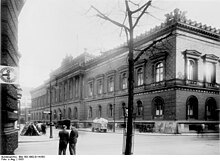 Reichsbank head office at Jägerstraße in Berlin, photographed in 1933 Reichsbank head office at Jägerstraße in Berlin, photographed in 1933 | |
| Headquarters | Berlin |
|---|---|
| Established | 1 January 1876 (1876-01-01) |
| Ownership | dispersed |
| President | Hermann von Dechend (1876-1890) Richard Koch (1890-1908) Rudolf Havenstein (1908-1923) Hjalmar Schacht (1923-1930, 1933-1939) Hans Luther (1930-1933) Walther Funk (1939-1945) |
| Central bank of | German Empire Weimar Republic Nazi Germany Nazi-occupied territories |
| Currency | German mark (1876-1924) Reichsmark (1924-1945) |
| Preceded by | Bank of Prussia (1876) Oesterreichische Nationalbank (1938) |
| Succeeded by | Bank deutscher Länder (West Germany) Deutsche Notenbank (GDR) Oesterreichische Nationalbank (Austria) National Bank of Poland Gosbank (East Prussia) Banque de France (Alsace-Lorraine) National Bank of Belgium (Luxembourg) |
The Reichsbank (German: [ˈʁaɪçsˌbank] ; lit. 'Bank of the Reich') was the central bank of the German Empire from 1876 until the end of Nazi Germany in 1945.
Background
The monetary institutions in Germany had been unsuited for its economic development for several decades before unification. In the Kingdom of Prussia, the Bank of Prussia had been established in 1847 and, in the aftermath of the revolution of 1848, five additional banks had been granted a note-issuance privilege (the Berliner Kassenverein [de], Kölnische Privatbank, Magdeburger Privatbank, Ritterschaftliche Privatbank in Pommern at Stettin, and Städtische Bank in Breslau), but that was still insufficient to sustain adequate monetary conditions. By 1851, 9 banks in the whole of Germany (not including Austria) were chartered to issue banknotes, known as Notenbanken. In addition, most German states - with the only exceptions of Lippe and the Hanseatic cities of Bremen, Hamburg and Lübeck - issued government paper money without the intermediation of an issuing bank.
Several pan-German conventions were held with the aim to simplify and rationalize the German monetary system, e.g. in Vienna on 24 January 1857, but to no avail. Instead, the number of Notenbanken kept growing, reaching 31 (in the territories that would become the German Reich) in 1870. They were typically private-sector entities, albeit often under hands-on government oversight, except the Bank of Bremen and Frankfurter Bank which were comparatively independent. Twelve of these were in Prussia, four in the Kingdom of Saxony, one in the Kingdom of Bavaria, and the other 14 in various duchies, principalities and free cities.
On 27 March 1870, a law was passed that forbade the formation of further Notenbanken in the North German Confederation. Following the promulgation of the German Empire that law was extended to all German lands, with entry into force on 1 January 1872. These Prussian initiatives precipitated action by the Grand Duchy of Baden and Kingdom of Württemberg to create note-issuing banks of their own, respectively the Badische Bank in Mannheim (est. 1870) and the Württembergische Notenbank in Stuttgart (est. 1871), bringing the total number of Notenbanken to 33. The panic of 1873 further stimulated discussions on the creation of an integrated monetary system, which pitted advocates of centralization led by Ludwig Bamberger against the incumbent local banks of issue and defenders of state rights, led by Ludolf Camphausen. The political compromise was to allow the latter to keep issuance activity but under such restrictions that they rapidly fell into monetary irrelevance.
German Empire
The Reichsbank was established by legislation of the Reichstag of 14 March 1875, and assumed its new role on 1 January 1876 when it succeeded the Bank of Prussia. Meanwhile, between 1873 and 1875 the Bank of Prussia assumed all the assets and liabilities of the Hamburger Bank, which was a major monetary anchor in Northern Germany.

The Reichsbank was technically a private-sector company with individual shareholders, albeit not in joint-stock form, and operated from the start under the close control of the Reich government. The bank was managed by a management board (German: Direktorium) reporting to a supervisory board (German: Curatorium). The Curatorium was chaired by the Imperial Chancellor and included four additional members, one appointed by the emperor and the other three by the Bundesrat; it was to meet every three months. The Direktorium was led by the President (German: Reichsbankpräsident) and all its members were appointed for life by the emperor, upon nomination by the Bundesrat. The law specified that the Direktorium must obey the Chancellor's orders at all times. The shareholders were represented in a central committee (German: Zentralausschuss) of 15 members, which met at least every month under the chairmanship of the Reichsbank's president and could scrutinize the management but not change it or influence policy decision. Three deputies of the Zentralausschuss were allowed to attend all meetings of the Direktorium and to examine the books of the Reichsbank. The initial shareholders included the former shareholders of the Bank of Prussia (except a few who opted for selling their shares) and new subscribers. The bank was exempted from all income and trade taxes, but also had to act as the Reich's fiscal agent without compensation.
The Reichsbank operated throughout the Reich's territory through a network of branches, which numbered 206 at its inception in 1876 and expanded to 330 by 1900. A formal distinction was made between main branches (German: Reichsbankhauptstellen), whose head was appointed directly by the emperor, and other branches (German: Reichsbankstellen), but that difference of status was insubstantial in practice. The bank's employees had the status of civil servants of the Reich, even though they were paid by the Reichsbank. The Reichsbank also sponsored the establishment of clearing houses which were established in the 1880s and 1890s in Berlin, Frankfurt, Stuttgart, Cologne, Leipzig (Petersstrasse), Dresden, Hamburg, Breslau, Bremen, and Elberfeld.
15 of the 32 Notenbanken (other than the Bank of Prussia) relinquished issuing their own banknotes shortly after the Reichsbank's creation; four more did so in the 1880s, six in the 1890s, and three in the early 1900s, leaving only the Bayerische Notenbank, Bank of Baden, Bank of Saxony and Württembergische Notenbank as residual note-issuing institutions by 1906.
Until World War I, the Reichsbank produced a very stable currency, fully convertible into gold and thus known as the German gold mark. In 1909, an amendment to the Banking Act of 1875 made the Rischsbank's notes legal tender and redeemable at the rate of 2790 Marks per kilogram of gold. In the period immediately before the war erupted, the Reichsbank greatly increased its gold reserves, as also did the Bank of France, Bank of Russia and Austro-Hungarian Bank, from an equivalent US$184 million on 31 December 1912 to $336 million on 30 June 1914. At the outbreak of World War I, however, the link between the mark and gold was abandoned, resulting in the Papiermark. The expenses of the war caused inflationary pressure and the mark started to decrease in value..
Weimar Republic


Following Germany's defeat and the 1919 Treaty of Versailles, the German government was unable to meet its expenditures and commitments by taxation and borrowing from external sources, and instead turned to the Reichsbank for monetary financing. Combined with its reaction to the occupation of the Ruhr by France and Belgium, this triggered a dramatic episode of hyperinflation that rendered the Mark practically worthless. The Reichsbank only started raising its discount rate in July 1922, reaching 40 percent per day at the hyperinflationary peak in November 1923. By decree of 15 October 1923 on the initiative of finance minister Hans Luther, the government created a separate bank, the Deutsche Rentenbank, endowed with the right to issue notes (German: Rentenbankscheine) redeemable in a kind of non-interest-bearing mortgage bond, the Rentenbrief, denominated in gold Mark and theoretically backed by a collective mortgage debt imposed upon German agriculture and industry. That confidence-building initiative succeeded against all expectations, even though the Rentenbankscheine only had the status of "legally-admitted medium of exchange" while the Reichsbank's devalued paper notes remained legal tender. No fixed exchange rate was set by law, but the "Rentenmark" became interchangeable with paper Mark at the rate of one to one trillion. The Rentenmark was thus in effect a transitory domestic currency, which was never convertible internationally.
The success of the Rentenmark, followed by the Dawes Plan on war reparations, paved the way for a restoration of monetary order. The Banking Law of 30 August 1924 was inspired by the stabilization loans orchestrated by the Economic and Financial Organization of the League of Nations that had entailed the creation of the Oesterreichische Nationalbank in January 1923 and of the Hungarian National Bank in June 1924. It comprehensively reformed the Reichsbank and made it, for the first time, an explicitly independent central bank. Its Kuratorium was replaced by a General Council (German: Generalrat) consisting of 7 German and 7 foreign members, which was to elect the bank's president subject to approval of the President of Germany. The General Council also elected one of its foreign members to serve as Currency Commissioner (German: Komissar für die Notenausgabe) supervising note issuance. The ability of the reformed Reichsbank to extend credit to the Reich government was strictly limited. The new currency, the Reichsmark (RM), was set at one trillion paper Mark, restoring the prewar parity of 2790 RM for one kilogram of fine gold; the pre-reform notes ceased to be legal tender on 5 June 1925.
In the subsequent period of deflation, the Reichsbank became practically the only source of short-term banking credit in the German economy, which it chose to ration (maintaining a discount rate of no more than 10 percent) rather than lending to high market-determined rates. The Reichsbank's credit rationing only ended in early 1926, after which the discount rate could be gradually lowered, reaching 56 percent in January 1927. In 1930, legislative amendments in line with the Young Plan brought an end to the involvement of foreigners in the Reichsbank's governance. The General Council was reduced to 10 members, all German, and the role of Currency Commissioner went to the President of the Rechnungshof des Deutschen Reiches [de].
Nazi period


The Nazi regime promptly put an end to the independence of the Reichsbank and made it an instrument of their policy of directing Germany's resources towards rearmament and military expansion. By amendment of 27 October 1933 to the Banking Law, the General Council was abolished and the Direktorium, including the President, were henceforth to be directly appointed and dismissed by the Führer. On 30 January 1937, Hitler publicly proclaimed the unlimited sovereignty of the Reich over the Reichsbank, and a lew of 18 February 1937 formally abolished the Reichsbank's autonomous status. Another law of 15 June 1939 stipulated that the President and Direktorium should directly receive their instructions from the Führer, and renamed the bank as Deutsche Reichsbank. During most of the Nazi period the same individual was President of the Reichsbank and Minister of the Economy, namely Hjalmar Schacht from August 1934 to November 1937 and Walther Funk from January 1939 to May 1945.
On 31 December 1935, the Reichsbank's note issuing privilege became exclusive, bringing an end to the residual central banking roles of the Bank of Baden, Bayerische Notenbank, Bank of Saxony, and Württembergische Notenbank.
The Reichsbank benefited from the theft of the property of numerous governments invaded by the Germans, especially their gold reserves and much personal property of the Third Reich's many victims, especially the Jews. Personal possessions such as gold wedding rings were confiscated from prisoners, and gold teeth torn from dead bodies, and after cleaning, were deposited in the bank under the false-name Max Heiliger accounts, and melted down as bullion.
In April and May 1945, the remaining reserves of the Reichsbank – gold (730 bars), cash (6 large sacks), and precious stones and metals such as platinum (25 sealed boxes) – were dispatched by Walther Funk to be buried on the Klausenhof Mountain at Einsiedl in Bavaria, where the final German resistance was to be concentrated. Similarly, the Abwehr cash reserves were hidden nearby in Garmisch-Partenkirchen. Shortly after the American forces overran the area, the reserves and money disappeared. Funk would be tried and convicted of war crimes at the Nuremberg trials, not least for receiving money and goods stolen from Jewish and other victims of the Nazi concentration camps. Gold teeth extracted from the mouths of victims were found in 1945 in the vaults of the bank in Berlin. The explanation of the disappearance of the Reichsbank reserves in 1945 was uncovered by Bill Stanley Moss and Andrew Kennedy, in post-war Germany.
Aftermath and liquidation
In line with decisions made at the Potsdam Conference, the Reichsbank was placed under joint Allied custodianship pending its liquidation. The four occupying powers (France, the Soviet Union, the United Kingdom and the United States) initially continued to issue Reichsmarks and Allied military marks. In Austria, the Oesterreichische Nationalbank was re-established by the Central Bank Transition Act of 3 July 1945 of the Second Austrian Republic.
In line with the Morgenthau Plan, the American authorities in November 1945 proposed a radically decentralized plan that would have organized a separate financial system in each of the Länder, with minimal central coordination. After some hesitancy, the French authorities rallied that vision; the British authorities were initially reluctant, but gradually aligned with U.S. views following the establishment of the Bizone on 1 January 1947. Thus, Land central banks (German: Landeszentralbanken) were created on 1 January 1947 in American-occupied Munich (for Bavaria), Stuttgart (for Württemberg-Baden), and Wiesbaden (for Hesse), followed in March by French-occupied Tübingen (for Württemberg-Hohenzollern), Freiburg im Breisgau (for South Baden, and Mainz (for Rhineland-Palatinate), then American-occupied Bremen on 1 April 1947, and eventually British-occupied Düsseldorf (for North Rhine-Westphalia), Hanover (for Lower Saxony), Kiel (for Schleswig-Holstein) and Hamburg by the Spring of 1948.
In the Soviet occupation zone, ostensibly similar entities dubbed Emissions- und Girobanken were established in May 1947 in each of the zone's five Provinces, namely in Potsdam for Brandenburg, Rostock for Mecklenburg, Dresden for Saxony, Halle for Saxony-Anhalt, and Erfurt for Thuringia. Each of these was fully owned and controlled by the respective provincial authorities.
In 1947, newly appointed U.S. Military Governor Lucius D. Clay decided, against directives from Washington, that Germany needed a central bank instead of a mere board bringing together the Landeszentralbanken for joint policy decisions. An agreement on that concept was reached among the three Western occupying forces on 30 October 1947, resulting in the establishment on 1 March 1948 of the Bank deutscher Länder. On 21 May 1948, the Soviet occupation authorities replied by establishing a Deutsche Emissions- und Girobank in Potsdam, which was renamed Deutsche Notenbank in July, later relocated to East Berlin, and in 1968 was rebranded the Staatsbank der DDR.
Given Berlin's special situation, no Landezentralbank was initially established there. Plans for a separate currency for all of Berlin were considered up until June 1948, when the situation came to a head and the introduction of Western German marks into West Berlin precipitated the Berlin Blockade. Only after the blockade ended was the Berliner Zentralbank established on 20 March 1949, and initially operated under an association agreement with the Bank deutscher Länder. It was eventually converted into a Landezentralbank in 1957.
The Reichsbank itself went into a protracted process of liquidation. In 1955, a Federal German Law allowed holders of Reichsbank common stock to exchange it for interim certificates of the Bank Deutscher Länder.
Head office
The Bank of Prussia had commissioned a new head office in the late 1860s, which replaced its previous building dating from the late 17th century. The structure designed by architect Friedrich Hitzig was completed in 1876 as the Reichsbank started activity. In 1892-1894, the Reichsbank erected a palatial southward extension on an adjacent lot facing Hausvogteiplatz, designed by its architects Max Hasak [de] and Julius Emmerich [de]. In the early 1930s, the Reichsbank erected a large new facility on the other side of Kurstrasse, designed by its architect Heinrich Wolff [de]. While the main building was heavily damaged during World War II and eventually demolished in 1960, the 1930s extension survives as the Haus am Werderschen Markt, hosting the German Federal Foreign Office after having been the home of the Socialist Unity Party of Germany in the 1960s, 1970s and 1980s.
-
 The Reichsbank (upper right) in a display or recent Berlin architecture, late 1880s
The Reichsbank (upper right) in a display or recent Berlin architecture, late 1880s
-
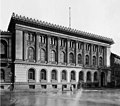 Extension on Hausvogteiplats, photographed in 1903
Extension on Hausvogteiplats, photographed in 1903
-
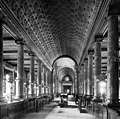 Banking hall of the Reichsbank, part of the 1890s extension
Banking hall of the Reichsbank, part of the 1890s extension
-
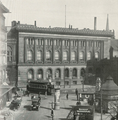 The bank's Hausvogtei front in 1928
The bank's Hausvogtei front in 1928
-
 1930s extension (Haus am Werderschen Markt)
1930s extension (Haus am Werderschen Markt)
Branches
In Prussia, the Reichsbank kept the branches it inherited from the Bank of Prussia, including buildings it had purchased from others (e.g. the palace erected by David Schindelmeißer [de] in Königsberg, acquired in 1843) and those it had built for itself (e.g. in Bromberg in 1864). Elsewhere, it did not take over the properties of banks whose monetary role it replaced, and erected new branch buildings instead. By the end of the 19th century, it had newly built branches in most of Germany's significant cities. In some cases, these branches were replaced by more modern ones in the interwar period.
The Reichsbank employed a number of specialized architects for branch design, including the prolific Max Hasak [de] and Julius Emmerich [de] from the 1880s to the early 1900s, Havestadt & Contag [de] in the 1890s and early 1900s, Curjel and Moser in the 1900s, Julius Habicht [de] and Hermann Stiller in the 1900s and 1910s, Philipp Nitze [de] in the 1910s and 1920s, and Heinrich Wolff [de] in the 1920s and 1930s.
Due to Germany's territorial losses following World War I, the former Reichsbank branches in what became the Second Polish Republic were taken over by Bank Polski, and the one in the Free City of Danzig became the Bank of Danzig. During World War II, a number of branches were destroyed and not subsequently rebuilt. The one in Munich, whose construction had started in 1938 on the site of the former Herzog-Max-Palais demolished that year, was only completed in 1951. Following the disappearance of the Reichsbank in 1945, a number of its former branches were taken over by its successor entities, namely the Deutsche Bundesbank in West Germany, the Staatsbank der DDR in East Germany, and the National Bank of Poland in Poland; some in East Germany were demolished later on, such as the Chemnitz branch in 1964. Many other branches have been repurposed for other uses over the years, such as the Bucerius Kunst Forum in Hamburg or the Dommuseum Ottonianum [de] in Magdeburg.
The addresses indicated below are the latest ones, which sometimes differ from original addresses due to street renaming and/or renumbering.
-
Aachen branch, Theaterstrasse 17 (arch. Hasak), completed 1889
-
 Brandenburg branch, Neustädter Markt 10 (arch. Hasak), completed 1902
Brandenburg branch, Neustädter Markt 10 (arch. Hasak), completed 1902
-
 Breslau (now Wrocław) branch, 10 Wolności Square, completed 1890
Breslau (now Wrocław) branch, 10 Wolności Square, completed 1890
-
 Bromberg (now Bydgoszcz) branch, Jagiellońska street 8 (arch. Hermann Cuno [de]), completed 1864
Bromberg (now Bydgoszcz) branch, Jagiellońska street 8 (arch. Hermann Cuno [de]), completed 1864
-
 Cologne branch, Unter Sachsenhausen 1-3 (arch. Hasak), at completion in 1896
Cologne branch, Unter Sachsenhausen 1-3 (arch. Hasak), at completion in 1896
-
 The same building in 2009, following damage in World War II
The same building in 2009, following damage in World War II
-
Danzig (now Gdańsk) branch [de], Karrenwall 10 (arch. Hasak), completed ca. 1904
-
The same building in 2010
-
 Darmstadt branch [de], Kasinostraße 5 (arch. Curjel and Moser), completed 1904
Darmstadt branch [de], Kasinostraße 5 (arch. Curjel and Moser), completed 1904
-
 Düsseldorf branch [de], Heinrich-Heine-Allee 8/9 (arch. Emmerich), completed 1894
Düsseldorf branch [de], Heinrich-Heine-Allee 8/9 (arch. Emmerich), completed 1894
-
 Dresden branch [de], St. Petersburger Strasse 2 (arch. Wolff), completed 1930
Dresden branch [de], St. Petersburger Strasse 2 (arch. Wolff), completed 1930
-
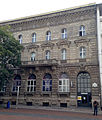 Duisburg branch, Düsseldorfer Strasse 21 (arch. Stiller), completed 1897
Duisburg branch, Düsseldorfer Strasse 21 (arch. Stiller), completed 1897
-
 Elberfeld branch, Bankstrasse 23 (arch. Hasak), completed 1892
Elberfeld branch, Bankstrasse 23 (arch. Hasak), completed 1892
-
 Eisenach branch [de], Karl-Marx-Straße 53, completed 1905
Eisenach branch [de], Karl-Marx-Straße 53, completed 1905
-
Elbing (now Elbląg) branch, ulica 1 Maja 16 (arch. Habicht), completed 1910
-
 Werden, Essen branch, Wesselswerth 9, completed 1902
Werden, Essen branch, Wesselswerth 9, completed 1902
-
 Frankfurt branch, Taunusanlage 4-6 (arch. Amsler & Wolff), completed 1933, renovated in the 1980s
Frankfurt branch, Taunusanlage 4-6 (arch. Amsler & Wolff), completed 1933, renovated in the 1980s
-
 Freiburg im Breisgau branch, Leopoldring 9 (arch. Hasak), completed 1902
Freiburg im Breisgau branch, Leopoldring 9 (arch. Hasak), completed 1902
-
 Fulda branch, Rabanusstrasse 12 (arch. Hasak), completed 1902
Fulda branch, Rabanusstrasse 12 (arch. Hasak), completed 1902
-
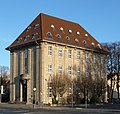 Göttingen branch, Berliner Strasse 5, completed 1909
Göttingen branch, Berliner Strasse 5, completed 1909
-
 Hamborn (Duisburg) branch, Duisburger Straße 216, completed 1908
Hamborn (Duisburg) branch, Duisburger Straße 216, completed 1908
-
 Hamburg branch, Rathausmarkt 2 (arch. Habicht & Nitze), completed 1919
Hamburg branch, Rathausmarkt 2 (arch. Habicht & Nitze), completed 1919
-
 Hanover branch [de], Georgsplatz 5 (arch. Hasak, Havestadt & Contag), completed 1896
Hanover branch [de], Georgsplatz 5 (arch. Hasak, Havestadt & Contag), completed 1896
-
 Hildesheim branch, Zingel 34 (arch. Hasak), completed 1897
Hildesheim branch, Zingel 34 (arch. Hasak), completed 1897
-
 Hörde (Dortmund) branch, Penningskamp 7, completed 1909
Hörde (Dortmund) branch, Penningskamp 7, completed 1909
-
 Karlsruhe branch, Herrenstrasse 30 (arch. Hasak, Havestadt & Contag), completed 1893
Karlsruhe branch, Herrenstrasse 30 (arch. Hasak, Havestadt & Contag), completed 1893
-
 Kattowitz (now Katowice) branch, Bankowa 5 (arch. Habicht), completed 1911
Kattowitz (now Katowice) branch, Bankowa 5 (arch. Habicht), completed 1911
-
 Kiel branch, Fleethörn 29 (early 20th century photograph)
Kiel branch, Fleethörn 29 (early 20th century photograph)
-
 Krefeld branch, Friedrichsplatz 20 (arch. Stiller), completed 1906
Krefeld branch, Friedrichsplatz 20 (arch. Stiller), completed 1906
-
Königsberg (now Kaliningrad) branch, Grosser Domplatz, erected in the late 18th century, destroyed in World War II
-
 Leipzig branch [de], Petersstrasse 43 (arch. Hasak), completed 1887
Leipzig branch [de], Petersstrasse 43 (arch. Hasak), completed 1887
-
Lübeck branch, Königsstrasse 45 (arch. Hasak), completed 1895
-
Lübeck new branch [de], Holstentorplatz 2 (arch. Wolff), completed 1936
-
 Magdeburg branch [de], Domplatz 15 (arch. Nitze), completed 1923
Magdeburg branch [de], Domplatz 15 (arch. Nitze), completed 1923
-
Mainz branch, Kaiserstraße 52 (arch. Hasak, Havestadt & Contag), completed 1892
-
 Metz branch [fr], 10-12 avenue Foch (arch. Curjel et Moser), completed 1907
Metz branch [fr], 10-12 avenue Foch (arch. Curjel et Moser), completed 1907
-
 Munich branch, Ludwigstrasse 13 (arch. Wolff, then Carl Sattler), completed 1951 for the Bayerische Landeszentralbank
Munich branch, Ludwigstrasse 13 (arch. Wolff, then Carl Sattler), completed 1951 for the Bayerische Landeszentralbank
-
 Münster branch, Domplatz 36 (arch. Hasak, Havestadt & Contag), completed 1894
Münster branch, Domplatz 36 (arch. Hasak, Havestadt & Contag), completed 1894
-
 Poznań branch [pl], al. Marcinkowskiego 12 (arch. Habicht), completed 1912 or 1913
Poznań branch [pl], al. Marcinkowskiego 12 (arch. Habicht), completed 1912 or 1913
-
 Siegen branch [de], Spandauer Straße 40 (arch. Habicht), completed 1911
Siegen branch [de], Spandauer Straße 40 (arch. Habicht), completed 1911
-
 Stuttgart branch, Marstallstrasse 3 (arch. Hans Herkommer [de] & Theodor Bulling), completed 1923
Stuttgart branch, Marstallstrasse 3 (arch. Hans Herkommer [de] & Theodor Bulling), completed 1923
-
Thorn (now Toruń) branch, Plac Mariana Rapackiego (arch. Habicht), completed 1906
-
 Trier branch, Kochstrasse 13 (arch. Hasak), completed 1903
Trier branch, Kochstrasse 13 (arch. Hasak), completed 1903
Presidents
| No. | Picture | President of Reichsbank | Took office | Left office | Time in office |
|---|---|---|---|---|---|
| 1 |
 | Dechend, HermannHermann von Dechend (1814–1890) | 1876 | 1890 | 13–14 years |
| 2 |
 | Koch, RichardRichard Koch [de] (1834–1910) | 1890 | 1908 | 13–14 years |
| 3 |
 | Havenstein, RudolfRudolf Havenstein (1857–1923) | 1908 | 11 November 1923 | 14–15 years |
| 4 |
 | Schacht, HjalmarHjalmar Schacht (1877–1970) | 22 December 1923 (appointed Currency Commissioner on 12 November 1923) | 6 March 1930 | 6 years |
| 5 |
 | Luther, HansHans Luther (1879–1962) | 7 March 1930 | 17 March 1933 | 3 years |
| (4) |
 | Schacht, HjalmarHjalmar Schacht (1877–1970) | 18 March 1933 | 19 January 1939 | 5 years |
| 6 |
 | Funk, WaltherWalther Funk (1890–1960) | 20 January 1939 | 8 May 1945 | 6 years |
See also
References
- Budzinski, Prof Dr Oliver. "Definition: Reichsbank". wirtschaftslexikon.gabler.de (in German). Retrieved 2020-01-06.
- James M. Brophy (1992), "The Political Calculus of Capital: Banking and the Business Class in Prussia, 1848-1856", Central European History, 25 (2): 149–176, doi:10.1017/S0008938900020306, JSTOR 4546258
- Timothy W. Guinnane (2001), Delegated Monitors, Large and Small: The Development of Germany's Banking System, 1800-1914 (PDF), New Haven CT: Yale University Economic Growth Center
- ^ Charles Arthur Conant (1915). A History of Modern Banks of Issue. New York & London: G.P. Putnam's Sons.
- Jacob Riesser (1911), The German Great Banks and Their Concentration in connection with The Economic Development of Germany (PDF), Washington DC: National Monetary Commission
- ^ National Monetary Commission (1910). "The Reichsbank 1876-1900" (PDF). Washington DC: U.S. Senate.
- Harold James (1999), A historical perspective on international monetary arrangements: opening address (PDF), Federal Reserve Bank of Boston
- Charles Kindleberger (1993). A Financial History of Western Europe (Second ed.). Oxford University Press.
- Ulrich Bindseil (September 2019), Early French and German central bank charters and regulations (PDF), Frankfurt: European Central Bank
- "German Notes". 2018-01-06. Retrieved 2021-08-31.
- Heinz Fengler (1992), Geschichte der deutschen Notenbanken vor Einführung der Mark-Währung, Regenstauf: Gietl Verlag
- ^ Federal Reserve Board (March 1945), Army Service Forces Manual M356-5 / Military Government Handbook - Germany - Section 5: Money and Banking, Washington DC: U.S. Army Service Forces
- Moss, W. Stanley, Gold Is Where You Hide It; What Happened to the Reichsbank Treasure?, Andre Deutsch 1959
- ^ Hans A. Adler (August 1949), "The Post-War Reorganization of the German Banking System", Quarterly Journal of Economics, 63 (3), Oxford University Press: 322–341, doi:10.2307/1882258, JSTOR 1882258
- "1945-1998: The Oesterreichische Nationalbank during the Second Republic". Oesterreichische Nationalbank.
- "50 Jahre Landeszentralbank in Berlin und Brandenburg 1949 - 1999". Deutsche Bundesbank. Archived from the original on 2023-12-30. Retrieved 2023-12-30.
- George H. Morison (12 December 1955). "Reichsbank Plan Agitates Zurich; Liquidation Bill Held Unfair to Stockholders of Discount Bank, a Subsidiary". New York Times.
- Thomas Müller. "Das Herzog-Max-Palais: Ein Abriss zugunsten der "Hauptstadt der Deutschen Kunst". Munich Art To Go.
- "Reichsbank – Hier ist ihr Geld sicher". chemnitz-gestern-heute.de. August 2020.
- Jacek Kulesza (11 December 2015). "AC Hotel by Marriott powstanie w gmachu dawnego Banku Rzeszy". wyborcza.pl.
- Walter Buschmann and Alexander Kierdorf. "Bankenviertel Köln". Rheinische Industriekultur.
- "Reichsbankgebäude Eisenach". Architektur Bildarchiv.
- Adrian Sajko (13 August 2014). "Bank opuszcza zabytkowy budynek przy 1 Maja. Kupiec pilnie poszukiwany". info.elblag.pl.
- "Ehemalige Reichsbank". Essener Ruhrperlen.
- Gottfried Kiesow (December 2011). "Die Baukunst zwischen den Weltkriegen". Monumente.
- "LZB Landeszentralbank in Hessen, Frankfurt am Main". Jourdain & Müller Steinhauser Architekten.
- "Ehemalige Reichsbank". duisburg.de.
- "150 lat Katowic. Kocur dostał dwa lwy i wypalił fajkę pokoju". wyborcza.pl. 1 August 2015.
- "Königsberg (Pr.), Großer Domplatz, Reichsbank (Schindelmeißer-Haus)". Ostpreussen Bildarchiv.
- "Reichsbank-Gebäude Lübeck". Architektur Bildarchiv.
- "Die Reichsbank am Breiten Weg". Ottostadt Magdeburg.
- Iris Cramer and Sabine Muschler. "Architektur und Kunst: Deutsche Bundesbank Hauptverwaltung in Baden-Württemberg" (PDF). Deutsche Bundesbank.
- Marsh, David (1992). The Most Powerful Bank: Inside Germany's Bundesbank. New York: Times Books. p. 85. ISBN 0-8129-2158-5.
- Marsh, David (1992). The Most Powerful Bank: Inside Germany's Bundesbank. New York: Times Books. p. 84. ISBN 0-8129-2158-5.
External links
 Media related to Reichsbank at Wikimedia Commons
Media related to Reichsbank at Wikimedia Commons- Documents and clippings about Reichsbank in the 20th Century Press Archives of the ZBW